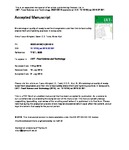Microbiological quality of ready-to-eat fresh vegetables and their link to food safety environment and handling practices in restaurants
| dc.contributor.author | Faour-Klingbeil, D | |
| dc.contributor.author | Todd, ECD | |
| dc.contributor.author | Kuri, Victor | |
| dc.date.accessioned | 2016-07-28T11:18:59Z | |
| dc.date.available | 2016-07-28T11:18:59Z | |
| dc.date.issued | 2016-12 | |
| dc.identifier.issn | 0023-6438 | |
| dc.identifier.issn | 1096-1127 | |
| dc.identifier.uri | http://hdl.handle.net/10026.1/5125 | |
| dc.description | Accepted, unedited manuscript- Published on-line 22-July-2016 Pending copyediting, typesetting, and reviewing of proof, and publishing in its final form. | |
| dc.description.abstract |
he increased consumption of ready-to-eat salads outside homes as a result of a fast paced lifestyle, awareness on their nutritional attributes and enhanced processing technology is well documented. This study aimed to determine the microbiological quality of fresh-cut salads vegetables in small and medium sized foodservice establishments (SMEs) and to identify risk factors and handling practices through observational assessment in order to investigate if an association between microbiological quality and visual assessment (inspection) scores can be established. A total of 118 samples fresh-cut vegetable salads were collected from 50 inspected locations and analysed microbiologically, in addition to 49 swabs of knives and cutting boards. There was no statistically significant correlation between visual assessment scores and bacteriological counts on vegetables or cutting boards. Nonetheless, the consistent relationship between inspection ratings on cross-contamination and cleaning components and Listeria spp. levels was statistically significant. This study demonstrated that overall visual assessment scores would not directly reflect the safety of salad vegetables and that the significance of microbiological assessment should be considered in relation to individual inspection components. It is necessary to place effective control measures on cleaning standards and risk of cross-contamination to improve the microbiological safety of fresh salad vegetables in SMEs | |
| dc.format.extent | 224-233 | |
| dc.format.medium | Undetermined | |
| dc.language | en | |
| dc.language.iso | en | |
| dc.publisher | Elsevier Ltd. | |
| dc.subject | Ready-to-eat salads | |
| dc.subject | Hygiene | |
| dc.subject | Inspections | |
| dc.subject | Cross-contamination | |
| dc.subject | Microbiological quality | |
| dc.title | Microbiological quality of ready-to-eat fresh vegetables and their link to food safety environment and handling practices in restaurants | |
| dc.type | journal-article | |
| dc.type | Journal Article | |
| plymouth.author-url | https://www.webofscience.com/api/gateway?GWVersion=2&SrcApp=PARTNER_APP&SrcAuth=LinksAMR&KeyUT=WOS:000383524300031&DestLinkType=FullRecord&DestApp=ALL_WOS&UsrCustomerID=11bb513d99f797142bcfeffcc58ea008 | |
| plymouth.issue | 12 | |
| plymouth.volume | 74 | |
| plymouth.publisher-url | https://www.elsevier.com/ | |
| plymouth.publication-status | Accepted | |
| plymouth.journal | LWT - Food Science and Technology | |
| dc.identifier.doi | 10.1016/j.lwt.2016.07.051 | |
| plymouth.organisational-group | /Plymouth | |
| plymouth.organisational-group | /Plymouth/Faculty of Science and Engineering | |
| plymouth.organisational-group | /Plymouth/Faculty of Science and Engineering/School of Biological and Marine Sciences | |
| plymouth.organisational-group | /Plymouth/REF 2021 Researchers by UoA | |
| plymouth.organisational-group | /Plymouth/REF 2021 Researchers by UoA/UoA06 Agriculture, Veterinary and Food Science | |
| plymouth.organisational-group | /Plymouth/Users by role | |
| plymouth.organisational-group | /Plymouth/Users by role/Academics | |
| dcterms.dateAccepted | 2016-07-21 | |
| dc.rights.embargodate | 2017-7-25 | |
| dc.identifier.eissn | 1096-1127 | |
| dc.rights.embargoperiod | No embargo | |
| rioxxterms.versionofrecord | 10.1016/j.lwt.2016.07.051 | |
| rioxxterms.licenseref.uri | http://www.rioxx.net/licenses/all-rights-reserved | |
| rioxxterms.licenseref.startdate | 2016-12 | |
| rioxxterms.type | Journal Article/Review |


